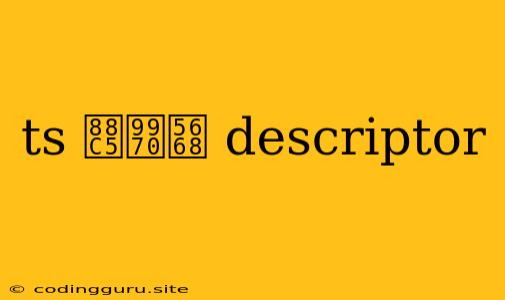Understanding TypeScript Decorators and Descriptors: A Deeper Dive
TypeScript decorators are a powerful feature that allows you to add metadata and modify the behavior of classes, methods, properties, and parameters. They offer a concise and expressive way to enhance your code, making it more readable and maintainable. But what exactly are they and how do they work? Let's explore this with a focus on the role of descriptors.
What are TypeScript Decorators?
Decorators are essentially functions that are applied to a class, method, property, or parameter using the @ symbol. They are effectively syntactic sugar for a more structured and readable way to work with descriptors, which are the underlying mechanisms that power decorators.
Descriptors: The Heart of Decorators
Descriptors provide a way to access and modify the metadata associated with a class, method, property, or parameter. They are objects that describe the behavior of these elements in your code.
Types of Descriptors:
- Data Descriptors: These descriptors define the behavior of properties. They contain properties like
value,writable,enumerable, andconfigurable. - Accessor Descriptors: These descriptors control how properties are accessed and modified. They have properties like
getandset, which are functions used to retrieve and change the value of the property respectively.
How Decorators Work with Descriptors
When a decorator is applied, it receives the descriptor of the decorated element as an argument. This allows the decorator to modify the descriptor and change the behavior of the decorated element.
Example:
function LogProperty(target: any, propertyKey: string): void {
let value: any;
const descriptor: PropertyDescriptor = {
get() {
console.log(`Getting value for ${propertyKey}`);
return value;
},
set(newValue: any) {
console.log(`Setting value for ${propertyKey}: ${newValue}`);
value = newValue;
}
};
Object.defineProperty(target, propertyKey, descriptor);
}
class MyClass {
@LogProperty
name: string;
}
const myInstance = new MyClass();
myInstance.name = "John"; // Output: Setting value for name: John
console.log(myInstance.name); // Output: Getting value for name
In this example, the LogProperty decorator modifies the descriptor of the name property. This changes its behavior, logging messages whenever the property is accessed or modified.
Why Use Decorators and Descriptors?
- Code Reusability: Decorators allow you to reuse the same logic across multiple elements of your code.
- Enhanced Readability: They provide a clear and concise syntax for modifying class members.
- Flexibility: They offer a flexible way to modify the behavior of your code at runtime.
- Modularization: You can easily separate concerns and create modular code.
Common Applications of Decorators
- Validation: Use decorators to implement input validation for methods and properties.
- Logging: Decorate methods to log information about function calls.
- Authorization: Check user permissions using decorators for method access control.
- Dependency Injection: Inject dependencies into classes using decorators.
- Data Transformation: Apply decorators to transform data before or after it is used.
Tips for Using Descriptors Effectively
- Understand the Purpose: Clearly define the goal of your decorator before implementing it.
- Document Your Decorators: Provide clear documentation for your decorators to improve code understanding.
- Use Decorators Strategically: Use decorators judiciously to maintain code readability and avoid overusing them.
- Test Thoroughly: Test your decorators carefully to ensure they function as intended.
Conclusion
TypeScript decorators and descriptors provide a powerful and expressive mechanism for enhancing your code. They offer a structured and modular approach to modifying the behavior of your classes, methods, properties, and parameters. By leveraging the power of descriptors, you can write cleaner, more maintainable, and reusable code.
